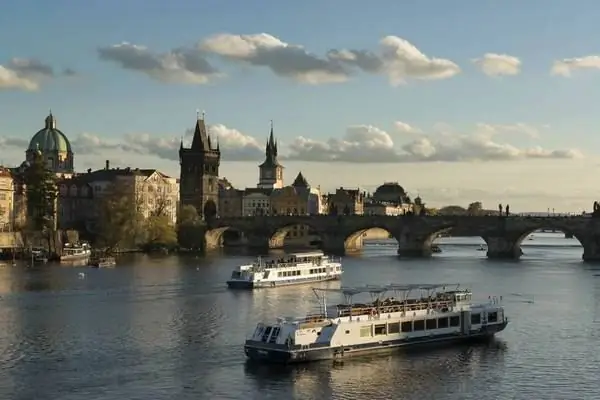
Description of the attraction
Charles Bridge is one of the few well-preserved medieval buildings, crossing the Vltava River. Until 1870 it was called Prague, it was named in honor of King Charles IV, who ordered its construction and laid the first stone.
Initially, numerous fords near the Prague Castle were used to cross the river, and after a while a wooden bridge was built, destroyed in 1157 by a flood. Under the protectorate of the Bishop of Prague Daniel, with the support of King Vladislav and Queen Jutta, a stone bridge was built in 1158-1172, supported by 27 arches. The crossing was strategically important, because it was the only one connecting the two banks of the city.
The bridge was decorated with sculptures, and towers were built at both ends. Large ice drift and low arched spans caused the complete destruction of the bridge in February 1342. One bridge tower on the Lesser Town side of the bridge and several of its arches, as well as the foundations at the bottom of the river, have survived to this day.
Charles IV bridge
In July 1357, at 5.31 am, the Czech ruler Charles IV placed the first stone in the masonry of the new bridge. The date and time of the laying were chosen on the recommendation of astrologers, should have contributed to the strength and durability of the structure. The work was supervised by the Czech-German architect Petr Parler. The construction was completed at the beginning of the 15th century under Wenceslas IV.
During the construction, previous miscalculations were taken into account - the Charles Bridge was higher, wider, located south of the previous one. In addition, the architects master Parler erected the Old Town Bridge Tower.
In 1432, a flood overtook Prague; five bridge arches were destroyed. The renovation began in the same year and was carried out until 1503. The storming of Prague by the Germans in 1611 and the battles on the bridge destroyed several pillars and sculptures, they were restored. Ice drift in 1784 damaged five pillars of the bridge, they were reinforced and rebuilt.
One of the first tram routes was laid along the Prague Bridge, before electrification in 1905 it was a horse tram, and then, until 1908, a tram with a current supply from below.
Architectural features
The Old Town Tower, designed by Parler, was built in the same style as St. Vitus Cathedral, with characteristic canopies. The ceremonial processions of the Czech rulers at the coronation passed through its vault. It is known that since the 20s of the 17th century, the severed heads of the leaders of the uprising of the estates were exhibited on the tower for intimidation.
The decoration of the building is sculptures from 1400 in the Gothic style, above are the heraldic shields of the lands within the Czech Republic. 138 steps lead to the gallery of the tower, the ceiling is a mesh vault. Currently, the tower houses an observation deck and the Charles Bridge Museum.
Lesser Towns towers served as defensive structures. Low tower - inheritance from the previous bridge, rebuilt in 1591, High - the foundation dates back to 1464, during the reign of Iriža Podebrad, renovation, decoration and modification - 1648. The relief, discovered in a sealed niche in the 19th century, belongs to Czech sculpture of the Romanesque period. The two towers are connected by a 15th century Gothic gate.
Bridge sculptures
Charles Bridge is decorated with thirty religious sculptures, most of which were installed in 1683-1714. Religious orders, university faculties, etc. had the right to erect the statue. There are 30 statues in total, the oldest and most famous is the statue of John of Nepomuk, the Prague archbishop, who was thrown into the Vltava from the Charles Bridge in 1393.
Most of the sculptures were made of sandstone, unstable to the influence of the external environment, and replaced with copies. The originals are in the National Museum and the Gorlitsa Museum in Vysehrad.






